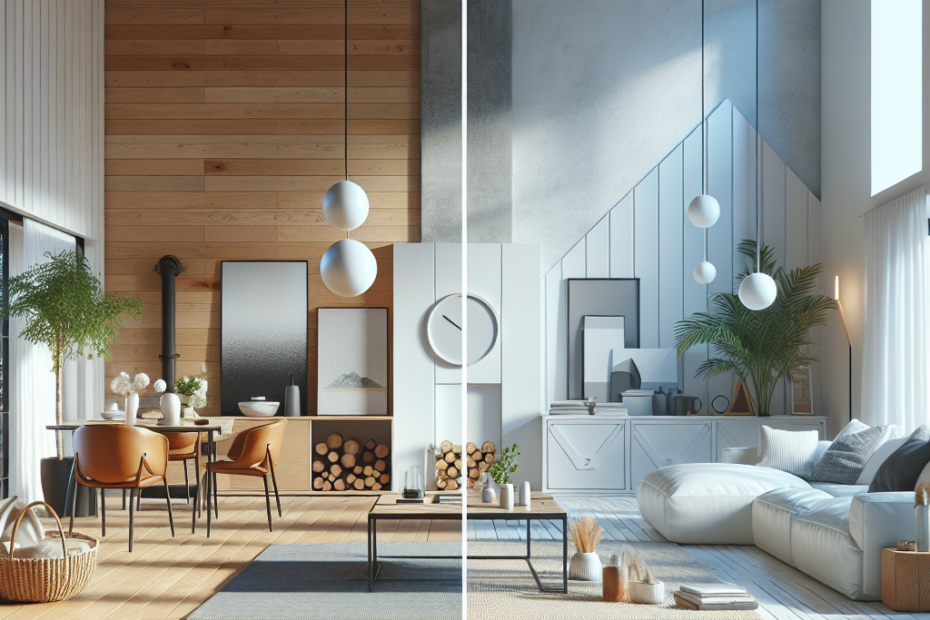Scandinavian vs. Minimalist Design: Which Is Right for You?
Many people are trying to make their homes look better. They often consider two popular interior design styles: Scandinavian and Minimalist. But what are these styles, and which one is the best choice for them? In this article, they will learn about the differences between Scandinavian and Minimalist design. They will also get tips on which design might fit their lifestyle.
Understanding Scandinavian Design
Scandinavian design originated in the Nordic countries of Norway, Sweden, Denmark, Finland, and Iceland. It’s known for its simplicity, functionality, and connection to nature. The main elements include light colors, natural materials, and cozy fabrics. The goal is to create a space that feels warm and inviting.
Key Features of Scandinavian Design
- Light Colors: White, beige, and soft pastels dominate.
- Natural Materials: Wood, wool, and leather are often used.
- Cozy Textures: Soft throws and rugs add warmth and comfort.
- Functional Furniture: Pieces are simple, practical, and often multi-use.
Understanding Minimalist Design
Minimalist design focuses on the idea that “less is more.” It’s all about reducing clutter and keeping only what is essential. The main elements include neutral colors, clean lines, and open spaces. The goal is to create a calm and orderly environment.
Key Features of Minimalist Design
- Neutral Colors: White, black, and shades of gray are common.
- Simple Furniture: Pieces have clean lines and lack ornamental details.
- Open Spaces: Rooms are often open and uncluttered.
- Essential Items Only: Each piece has a purpose, and unnecessary items are avoided.
Scandinavian vs. Minimalist Design: A Comparison
When comparing Scandinavian and Minimalist design, it is essential to identify the differences and similarities. Here is a table that highlights these points:
| Feature | Scandinavian Design | Minimalist Design |
|---|---|---|
| Color Palette | Light and pastel colors | Neutral colors like white, black, gray |
| Materials | Natural materials (wood, wool) | Varied materials, generally sleek and modern |
| Texture | Cozy and warm textures | Simple and functional textures |
| Furniture | Functional, often multi-use | Simple and clean lines |
| Space Utilization | Warm and inviting | Orderly and open |
Choosing the Right Design for Your Home
Picking between Scandinavian and Minimalist design depends on personal taste and lifestyle. They should ask themselves a few questions:
- Do they like warm, inviting spaces or clean, orderly environments?
- Do they prefer natural materials or sleek, modern finishes?
- What is more important: functionality and coziness or simplicity and decluttering?
In conclusion, both Scandinavian and Minimalist designs offer unique benefits. By understanding their differences, individuals can choose the one that best fits their needs.
Statistics and Trends
According to a survey by Houzz in 2022, 58% of homeowners chose Scandinavian design for its warmth and coziness, while 42% preferred Minimalist design for its simplicity and order (source: Houzz Home Design Trends Study, 2022). These statistics show that while both designs are popular, Scandinavian design has a slight edge in preference.
Key Takeaways
- Scandinavian design emphasizes light colors, natural materials, and cozy textures.
- Minimalist design focuses on neutral colors, clean lines, and open spaces.
- Scandinavian design feels warm and inviting, while Minimalist design feels calm and orderly.
- Choosing the right design depends on personal taste and lifestyle preferences.
- According to a survey, 58% of homeowners prefer Scandinavian design, while 42% prefer Minimalist design.
FAQ
Q1: What is the main difference between Scandinavian and Minimalist design?
A1: The primary difference is in their approach to space and materials. Scandinavian design uses light colors and natural materials to create a warm and cozy environment. Minimalist design emphasizes neutral colors, clean lines, and open spaces for a simple and orderly look.
Q2: Can I combine elements of both designs in my home?
A2: Yes, it’s possible to blend elements of both designs. For example, you can use light colors and natural materials from Scandinavian design and keep spaces uncluttered and simple like Minimalist design.
Q3: Which design is better for small spaces?
A3: Both designs can work well in small spaces. Minimalist design’s uncluttered approach can make a small room feel larger, while Scandinavian design’s light colors and cozy materials can make it feel warm and inviting.
Q4: Are there any similarities between the two designs?
A4: Yes, both designs favor simplicity and functionality. They avoid excessive ornamentation and focus on practical, beautiful spaces.
Q5: Which design trend is more popular right now?
A5: According to a 2022 Houzz survey, Scandinavian design is slightly more popular, with 58% of homeowners preferring its warmth and coziness compared to 42% who favor the simplicity of Minimalist design.
